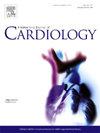Cardiovascular risk factors are associated with cerebrovascular reactivity in young adults
IF 3.2
2区 医学
Q2 CARDIAC & CARDIOVASCULAR SYSTEMS
引用次数: 0
Abstract
Introduction
Endothelial dysfunction represents the earliest detectable stage of atherosclerosis, is associated with an increased risk of cardiovascular events, and predicts cardiovascular disease (CVD) more effectively than traditional cardiovascular risk factors. Cerebrovascular reactivity (CVR) provides an index of endothelial function in the brain. Poor CVR is associated with stroke, cerebral small vessel disease, dementia, and even coronary artery disease. Traditional CVD risk factors are associated with low CVR in patients with known CVD and in older cohorts. However, the relationship between cardiovascular risk profile and reduced CVR in young adults who do not yet have CVD is uncertain. We hypothesized that in young adults undergoing routine clinical fMRI examinations for non-vascular disease low CVR measures would be associated with increased cardiovascular risk factors.
Methods
This cross-sectional study included adults with epilepsy undergoing a 3-Tesla fMRI scan of the brain for mapping of eloquent cortex with a “breath-hold task” to facilitate pre-operative planning for epilepsy-related surgery. Individuals with intracranial masses and those with baseline CVD were excluded. The task consisted of 5½, 20-s blocks of normal breathing interspersed with 20-s blocks of continuous breath holding. In breath hold fMRI scans, a voxel-wise comparison of brain T2 signal to an expected hemodynamic response curve is used to generate maps of voxel-wise t-statistics, indicating the probability that blood flow within a specific voxel had increased in response to changes in blood carbon dioxide levels. Using an axial slice 8 mm superior to the corpus callosum, a mean cerebral t-statistic was calculated for the slice as a comparative global measure of CVR in each patient. We retrospectively reviewed the charts of all individuals to characterize their clinical profile at the time of the fMRI. Based on the distribution of mean t-statistic values the sample was divided into two groups: high t-statistic (“normal reactivity”) and low t-statistic value (“abnormal reactivity”). The distribution of cardiovascular risk factors was then compared across groups.
Results
Between January 2014 and December 2023, 76 individuals underwent brain fMRI employing a “breath hold task” with suitable image quality for the current analysis (mean ± SD age, 35.46 ± 12.09 yrs.; 31.6 % female). Mean ± SD global CVR T-statistic was 3.97 ± 1.62. Low CVR was defined as a mean T-statistic ≤4.2 (n = 44, 57.9 %). Individuals with abnormal CVR were older (age: 45.1 ± 10.3 vs. 27.0 ± 3.4 yrs., p < 0.001), had a higher frequency of hypertension (31.8 % vs. 14.3 %, p = 0.0069) and hyperlipidemia (18.2 % vs. 3.1 %, p = 0.0449), and had higher systolic (123.5 ± 13.2 vs. 116.9 ± 12.2 mmHg, p = 0.0282) and diastolic blood pressures (77.9 ± 11.8 vs. 72.2 ± 8.9, p = 0.0141). Age, systolic blood pressure and hyperlipidemia were significantly associated with abnormal CVR in univariable and multivariable analyses (age, increase by 10 years OR: 2.00, 95 % CI 1.40–2.78, p = 0.0078; hyperlipidemia OR: 8.54, 95 % CI 1.07–184.9, p = 0.0049, and systolic blood pressure (OR for an increase in 10 mmHg: 1.57, 95 % CI 1.10–2.10, p = 0.0084).
Conclusion
Traditional cardiovascular risk factors, specifically age, systolic blood pressure and hyperlipidemia, are significantly associated with abnormal CVR in young adults without baseline CVD or cerebrovascular disease undergoing fMRI for reasons related to a diagnosis of epilepsy.
求助全文
约1分钟内获得全文
求助全文
来源期刊

International journal of cardiology
医学-心血管系统
CiteScore
6.80
自引率
5.70%
发文量
758
审稿时长
44 days
期刊介绍:
The International Journal of Cardiology is devoted to cardiology in the broadest sense. Both basic research and clinical papers can be submitted. The journal serves the interest of both practicing clinicians and researchers.
In addition to original papers, we are launching a range of new manuscript types, including Consensus and Position Papers, Systematic Reviews, Meta-analyses, and Short communications. Case reports are no longer acceptable. Controversial techniques, issues on health policy and social medicine are discussed and serve as useful tools for encouraging debate.
 求助内容:
求助内容: 应助结果提醒方式:
应助结果提醒方式:


